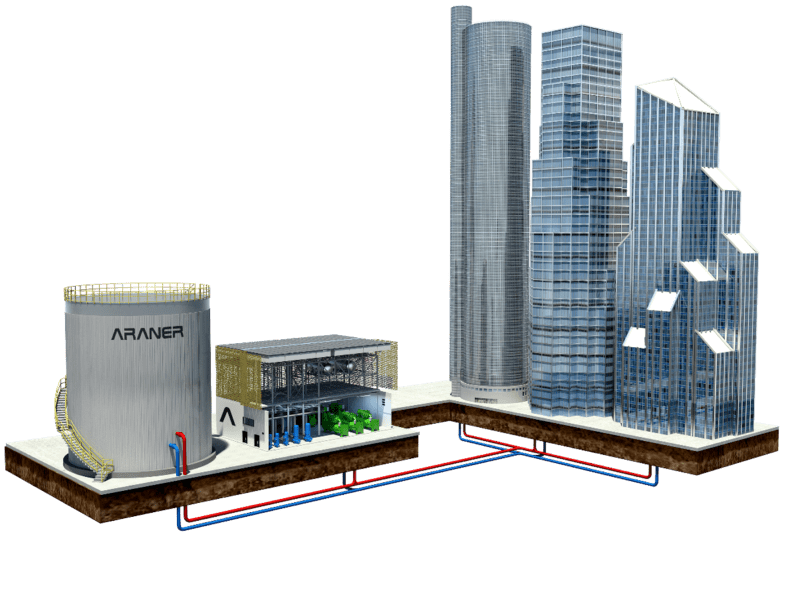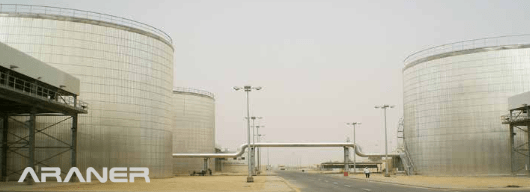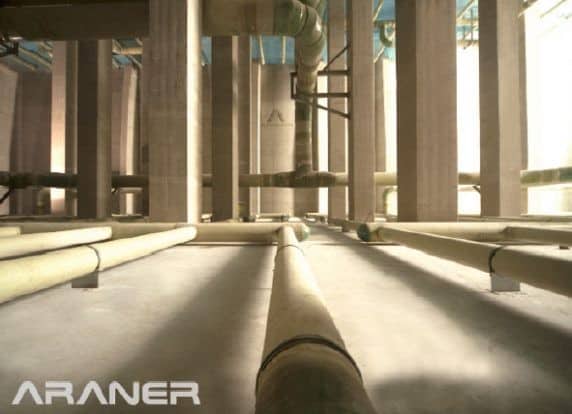Thermal energy storage (TES) is a valuable technology for electric grid systems, district heating and district cooling applications. TES tanks incorporated into district cooling systems help shift the cooling load from on-peak hours to off-peak hours. For district heating systems, the addition of alternatives such as solar and waste heat brings a lot of value. Electric grid systems are able to not only enhance system stability, but also shave peaks.

Fig 1: Diagram of a District Cooling System
If you are considering incorporating a TES tank to your operations for whatever reason, you can either use aboveground or underground tanks. Each of these options has advantages and disadvantages so you need to look at your needs closely vis-à-vis what is being offered. Let us have a close look at two categories below.
Aboveground TES Tank
Probably you have seen steel ground tanks standing alongside other structures in many facilities. Aboveground tanks-mostly of steel construction- are popular across the globe because they are suitable for a wide range of projects.

Fig 2: Aboveground TES tank
Another attractive characteristic of aboveground TES tanks is that they are more affordable over the long term and simpler to install compared to buried ones. Once you have installed them, maintenance is straightforward. In case any crack appears, the maintenance team is able to notice it quickly and repair. You rarely need complex and expensive tools to access the affected part. On the flip side, maintenance of above ground water storage tanks can be demanding in terms of frequency. If you are planning to install a steel tank, be sure to arm yourself with several maintenance guidelines. The fact that the tank is placed above ground means exposure to all kinds of elements. Accidents, vandalism and storms are just examples of external effects on these tanks. Excessively hot summers and winters can affect the effectiveness of above ground water storage tanks. For instance, these tanks have to withstand 90°F and above in outdoor air temperatures. Because of space limitations due to existing or planned structures, above ground water storage tanks tend to be smaller than buried tanks. This can hinder sizing freedom, which of course affects the amount of cooling capacity that you can factor in the design.
Underground TES Tank
These are usually concrete tanks that could be buried below landscape areas or parking. Alternatively, an underground TES tank could be placed in the basement together with other foundation components. To minimize the required pumping energy and piping network, these tanks should be located as close as possible to the load and chiller. An underground chilled water storage tank is an attractive solution if space is expensive. The amount of land used is minimal as compared to the above ground option.

Fig 3: Internal View of a Concrete TES tank
Many people tend to detest the visibility of the TES tank, as is the case in above ground water storage tanks. For the buried tank, there may be some pipes still visible, but the “eyesore” is at least out of sight. The problem of extreme weather conditions is minimal or even non-existent for underground tanks. These tanks are also out of harm from vandals and accidents. Furthermore, the ground offers them natural cover, thus allowing for consistent temperatures 24/7. Most underground tanks are of concrete construction, which makes them very expensive to install. Maintenance is minimal and removal unlikely, but if needed, the processes can be extremely costly. Concrete also tends to be porous, a feature that can cause water hardness in case of acidity. Larger pores will encourage growth of bacteria in the water.
Which water storage tank is better?
None of the options can be considered outright better than the other one. An optimal choice between these options depends on specific requirements such as budget, space availability, regulations and availability of maintenance expertise. Any installation or maintenance team is mostly concerned about leakages, water proliferation and such factors. As long as the requisite maintenance, budget and other requirements are available, any tank can support your chilled water preservation needs. We recommend a professional feasibility study to help you settle on either above ground or underground tank. Pick a reliable provider to help you analyze the cost (both initial and long term) and the load profile of your facility.










